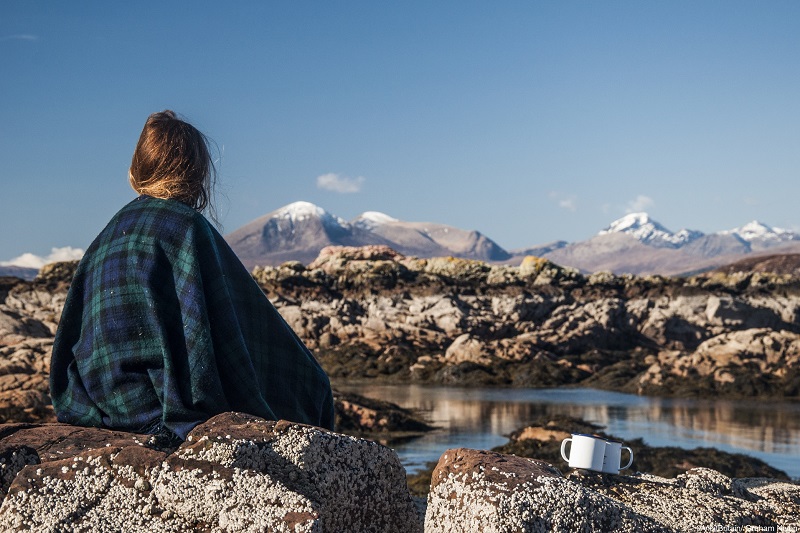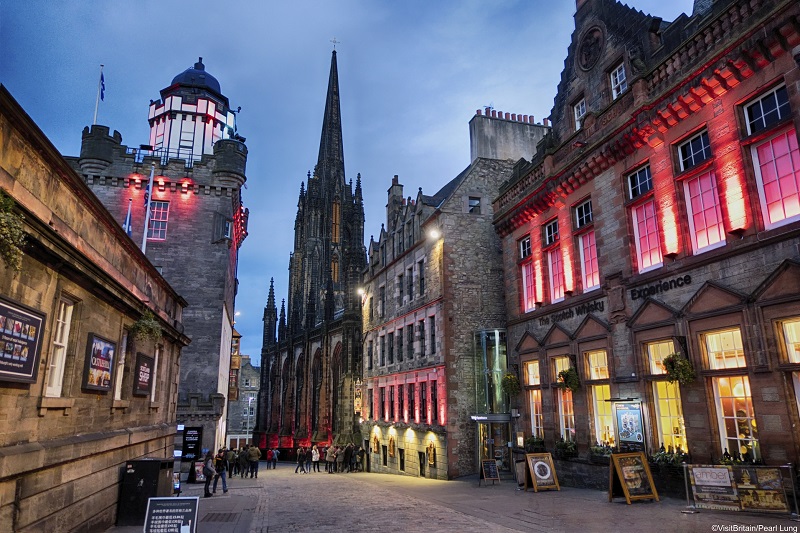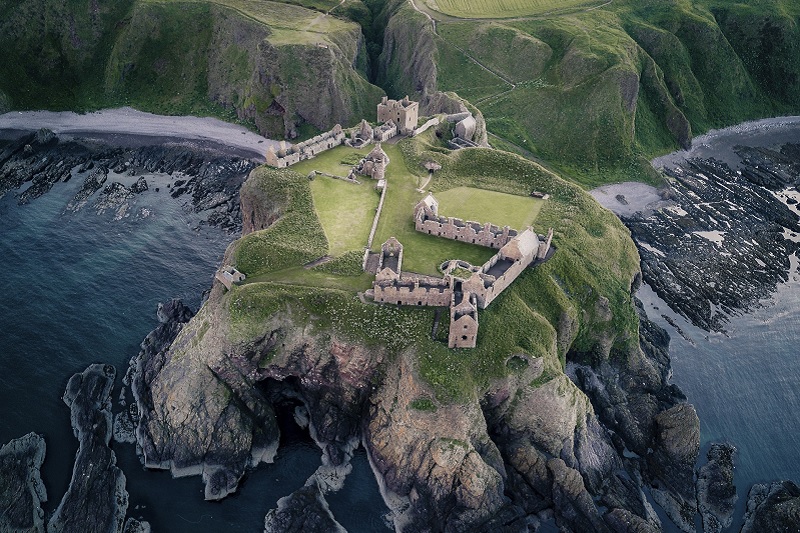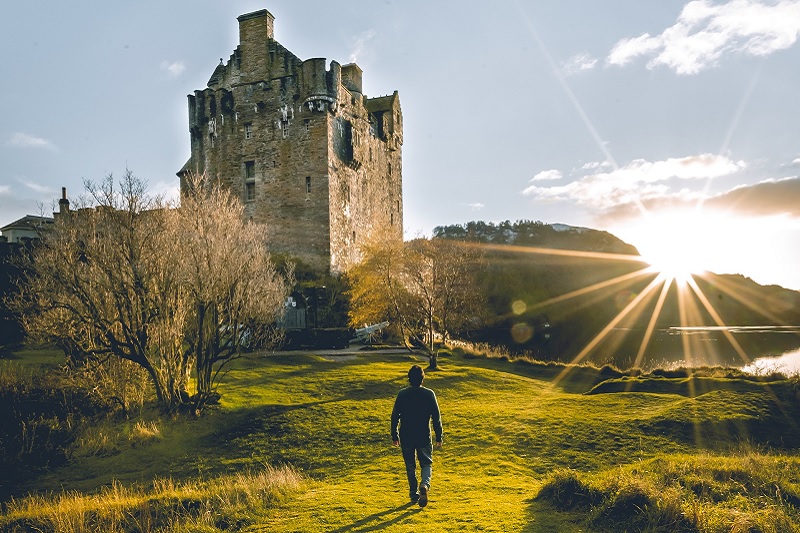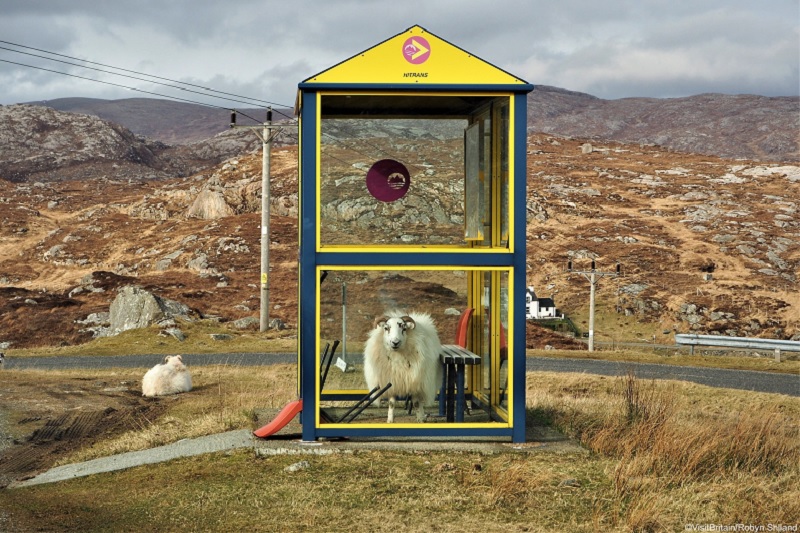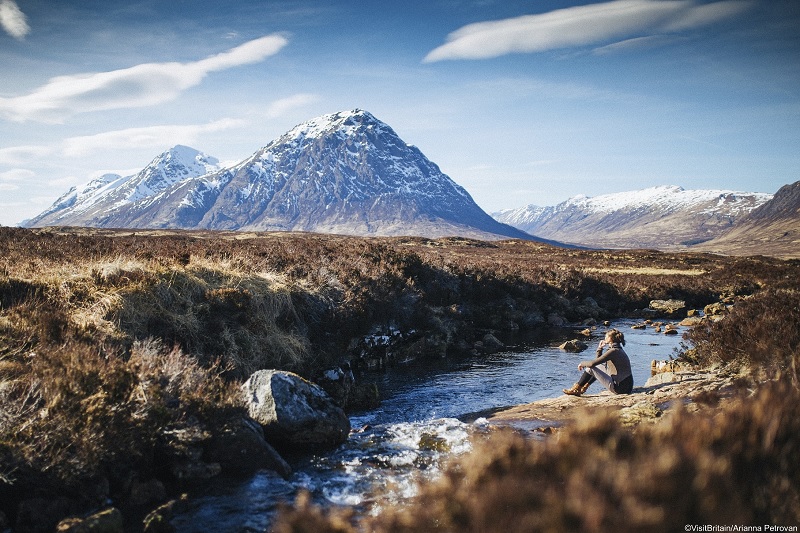Day 1 – Depart US
Day 2 – Arrive Edinburgh, Stirling & Loch Lomond
Upon arrival at Edinburgh Airport, collect your hire vehicle and set off for Stirling which is less than an hour’s drive away. Upon arrival you can check in at your hotel before exploring the city a little further. You will have
entrance to Wallace Monument included today.
Stirling is Scotland’s heritage capital, where the Wars of Independence were fought and won, where for three centuries monarchs ruled in regal splendour and where merchants and craftsmen plied their trade below the castle rock.
Nowadays you can feel the sense of history and nationhood which is Stirling’s trademark, as you enter the spectacular castle perched high above the city. The compact heritage mile that links Stirling’s Old Town with its bustling
modern city centre boasts the finest concentration of historic buildings in Scotland. Beautifully preserved medieval and Renaissance churches and mansions cluster around the Old Town, flanked by cobbled streets, period street
furniture and Victorian styled iron work. Overlooking the scene of one of Scotland’s most famous battle sites, Stirling Bridge, is the 220 ft high National Wallace Monument.=
Welcome to The National Wallace Monument, one of the most distinctive landmarks on the Stirling skyline, commemorating the Scottish patriot and martyr who triumphed over King Edward’s army at The Battle of Stirling Bridge. As you
climb towards the crown of the famous tower, each level tells the story of Scotland’s National Hero, and shows how his part in the history of Scotland has been recognised through the generations. The Hall of Arms shows how the
weapons of the time were used by Scottish and English warriors, while The Hall of Heroes displays the Wallace Sword, which struck fear into the hearts of Wallace’s enemies. From the crown of the Monument – the panoramic views
stretch out towards Loch Lomond, The Pentland Hills, Fife, and the Firth of Forth all the way to Edinburgh.
Colessio Hotel – Found in an original Victorian building and renovated to 21st century standards, Hotel Colessio is an opulent addition to the centre of Stirling. Free parking is possible on site, and free WiFi is accessible throughout.
Hotel Colessio’s exterior has been sympathetically restored to its former glory. Each bedroom and suite is light, spacious and furnished with high quality beds and down pillows and duvets. Rooms boast a flat-screen TV and iPod
dock, whilst the Philippe Starck bathrooms have luxury amenities from the White Company. The Grill Room is the property’s on site restaurant, boasting a Josper Grill in the kitchen and a menu based around traditional classics
with a modern twist. Alongside the restaurant is Hotel Colessio’s high-class cocktail and piano bar.
Accommodation: Colessio Hotel, Stirling
Day 3 – Stirling
This morning after breakfast, meet with your local guide for a guided walking tour of the city. Walk the cobbles streets of this old city and cap it off with a visit to the Castle which dominates the skyline. After bidding farewell
to your guide, head over to Deanstoun distillery for a whisky tasting experience. You may prefer to take a local taxi to and from the location.
Stirling Castle is one of Scotland’s grandest castles due to its imposing position and impressive architecture, Stirling Castle commands the countryside for many miles around. It towers over some of the most important battlefields
of Scotland’s past including Stirling Bridge, the site of William Wallace’s victory over the English in 1297, and Bannockburn where Robert the Bruce defeated the same foe in the summer of 1314. Situated on a volcanic outcrop
guarding the lowest crossing point of the River Forth, Stirling Castle is a great symbol of Scottish Independence and a source of enduring national pride. The castle’s long, turbulent history is associated with great figures
from Scotland’s past, such as William Wallace, Robert the Bruce and Mary Queen of Scots. It has seen many royal dramas and witnessed the lives and deaths of almost every Scottish monarch up to the Union of the Crowns in 1603.
Deanstoun Distillery. Enjoy an exclusive whisky tasting, straight from the cask in our Warehouse 4. Converted from an old cooperage, this room now houses casks of maturing whisky – the perfect backdrop to a unique and personal
dramming experience. We begin the tasting by talking about Deanston’s New Make spirit, before exploring the impact wood, time and climate have on forming the subtle, rich and complex flavors of our whisky. All of the casks we
taste in this experience have been carefully selected by our Master Blender. There will be an opportunity at the end of the tasting to purchase a 20cl bottle from your favorite casks in our distillery shop. These will be hand
filled and labelled by a member of the team. Please wear warm clothing as you will be sitting amongst our maturing casks which are housed in a consistently cool atmosphere. To take part in this experience, guests must be 18 years
of age or over.
Accommodation: Colessio Hotel, Stirling
Day 4 – Trossachs
Today you can set off in the car to the nearby Trossachs National Park. Reach Loch Katrine where you will board the lady of the lake for a cruise on the loch itself. The beauty of the Loch has long inspired some of Scotland’s most
famous writers, such as Sir Walter Scott, whose works included the ‘Lady of the Lake’ poem set on Loch Katrine. Afterwards you can take in some of the outstanding scenery as you go on a self guided walk on the Falls of Leny.
Return to Stirling in the evening for your final night in this region.
Trossachs National Park boasts some of the most stunning scenery in the world from the breathtaking mountains and glens of the Trossachs to the vast tranquil beauty of Loch Lomond, mainland UK’s largest body of water. National
Parks aren’t just for the rugged outdoor explorers, they’re for everyone. Whether it’s a sedate loch shore walk to calm your spirit or a day of munro bagging, a gentle cycle along a cycle path or a high octane mountain bike experience,
a comfortable canoe around our islands or a bracing open water swim, you’ll find it here and then some.
Cruise on Loch Katrine on the 45 minute sailing you will glide past stunning Trossachs landmarks such as Ben A’an and Ben Venue and glimpsing the mountains around the loch. Loch Katrine is a perfect place to start your Trossachs
adventure. The loch is best known for its magnificent scenery, the connection with Queen Victoria, much loved poet and author Sir Walter Scott and the birthplace of Rob Roy MacGregor. You will be taken back by the stunning views,
with chances to catch a glimpse of the resident wildlife.
Accommodation: Colessio Hotel, Stirling
Day 5 – Stirling to Glencoe
Charles Rennie Mackintosh is one of Scotland’s most celebrated architects and artists and his finest domestic creation can be found at Hill House, an arresting mix of arts and crafts, Art Nouveau and Scottish Baronial architecture
and design. Mackintosh designed nearly everything inside the Hill House, from the decorative schemes and the furniture to the fittings and contents. The beautiful, formal gardens have also been restored in line with the early
designs, using plants that would have been available at the time. Afterwards you will reach and stop at numerous viewpoints to see a landscape of majestic, somber beauty in Glencoe, one of Scotland’s most famous and scenic glens.
You will spend the next two evenings in this location
The finest of Charles Rennie Mackintosh’s domestic creations, this iconic house and gardens date back to 1902. The Hill House sits high above the Clyde in Helensburgh, commanding impressive views over the river. Hill House’s rooms
boast a timeless quality, appearing much more modern than their 1904 design would suggest. This is due in part to the level of detail Mackintosh poured into the project, which allegedly stretched to the architect suggesting the
colour of flowers the Blackies should place in their living room to ensure nothing clashed with the décor. An information room interprets the relationship between architect and patron and provides a historical context for Inspirations,
an exhibition in the upper east wing and the gardens. It brings together exceptional pieces of domestic design by great living designers, all of whom, in some way, pay homage to Mackintosh’s elegance and invention.
Glencoe really does merit the description ‘spectacular’. The best approach is from the south on the A82, one of the major routes through the Highlands. The road climbs over the bleak expanse of Rannoch Moor and drops down between
the steep scree-strewn sides of Glencoe. Awesome mountains such as Buachaille Etive Mor and the Three Sisters loom on either side, with riverine scenery at the bottom of the glen. The name Glencoe means ‘Valley of Weeping’, and
has a melancholy air thanks to it being the site of the Massacre of Glencoe in 1692. This was carried out by a regular regiment of the British army, under the command of Captain Robert Campbell of Glenlyon. The chief of the MacDonalds
of Glencoe had been slow to swear allegiance to William of Orange and the massacre was part of a wider government policy designed to bring pro-Jacobite clans to heel.
The Glencoe House serviced suites offers a truly unique experience in the luxury of a former Victorian mansion built in 1896 which has also been home to the Glencoe Hospital. The luxury suites offer the very best in hospitality
each featuring their own lounges and dinning room table, many have stunning views from its prime hillside location and some feature a private terrace. The property features wooden panelling throughout and most of the original
features are incorporate within the suites. Breakfast and food platters are available and delivered to your suite on request. Ample car parking is also available.
Accommodation: Glencoe House, Glencoe
Day 6 – Glencoe
Today you will meet with a local hiking guide for a private hike in the Glencoe area.
Accommodation: Glencoe House, Glencoe
Day 7 – Glencoe to Inverness
Today you will set off Northwards to Inverness. On the way you will drive alongside the famous Loch Ness. Stop off at Urquhart Castle to visit the ruins and try your hand a bit of Nessie spotting. Continue onwards up to Inverness
where you will meet a local guide for a 2 hour walking tour of the city. Your accommodation is located just outside the city at the wonderful Culloden House Estate.
Loch Ness is the deepest freshwater loch in the Scottish Highlands, and is one of the most visited locations in Scotland. Loch Ness is about 24 miles long by one mile wide and at its deepest point, it goes down nearly 1,000 ft.
Lying northeast of the Great Glen in the Highlands, Loch Ness is best known for alleged sightings of the crypto-zoological Loch Ness Monster, also known affectionately as “Nessie”.
Urquhart Castle offers a taste of the Highlands at their most dramatic. Discover 1,000 years of drama, experience a glimpse of medieval life and enjoy stunning views over Loch Ness from the ruins of the greatest castle in the Highlands.
Urquhart’s stories are also told through a remarkable collection of artefacts left by its residents, historic replicas, including a full-sized, working trebuchet siege engine. The castle has a distinctly Highland heritage and
the site has witnessed some of the most dramatic chapters in our nation’s history. It is here that St Columba is said to have worked miracles in the 6th century, where acts of chivalry and defiance provided inspiration during
the Wars of Independence and where the MacDonald Lords of the Isles struggled with the Crown for power.
Inverness is crowned by a pink crenelated castle and lavishly decorated with flowers, Inverness is a thriving city boasting historical buildings in the Old Town and peaceful areas close to the center. This thriving city offers
a rich variety of things to do and see from culture to eating and drinking. Enjoy the fine circular walk from Inverness Castle, currently a courthouse, along the river past St Andrew’s Cathedral, which dominates the River Ness,
and through the Ness Islands where you will find anglers casting long lines to leaping Atlantic salmon.
More than two centuries ago Bonnie Prince Charlie used Culloden House as his battle headquarters prior to that fateful and final battle on Culloden Moor. Nowadays this Inverness luxury hotel stands in nearly 40 acres where you
are free to wander about the elegant lawns and parkland to enjoy the exceptional peace, tranquility and majesty of the grounds. Undoubtedly the greatest asset is the staff. Here Highland hospitality has been elevated to its highest
art form without being “stuffy” nor too “proper” or reserved. The Hotels 28 luxury rooms offer all the mod cons with turndown service, newspapers and WI-FI all being complimentary. The Hotel also offers a large and comfortable
lounge along with a formal restaurant and bar lounge offering bar food and service.
Accommodation: Culloden House, Inverness
Day 8 – The North
Explore the Highland coastline and a castle which could have come straight out of a fairy tale. Dunrobin Castle, with its French chateau inspired design, conical spires and enchanting gardens will not disappoint. Dunrobin Castle
is one of Britain’s oldest continuously inhabited houses dating back to the early 1300s and was used as a naval hospital during the First World War and as a boy’s boarding school from 1965 to 1972. On our way back South, stop
off at Glenmorangie Distillery for a tour of this Highland whisky distillery.
Dunrobin Castle is the most northerly of Scotland’s great houses and the largest in the Northern Highlands with 189 rooms. Dunrobin Castle is also one of Britain’s oldest continuously inhabited houses dating back to the early 1300s,
home to the Earls and later, the Dukes of Sutherland. The Castle, which resembles a French château with its towering conical spires, has seen the architectural influences of Sir Charles Barry, who designed London’s Houses of
Parliament, and Scotland’s own Sir Robert Lorimer. The Castle was used as a naval hospital during the First World War and as a boys’ boarding school from 1965 to 1972.
By the tranquil shores of the Dornoch Firth, amidst the golden barley fields that border the Royal Burgh of Tain, lies the Glenmorangie Distillery where, accompanied by our expert guides, you will journey through all stages of
our award-winning whisky creation, from mashing and fermenting to distilling and maturation. Here you will find a warm Highland welcome from our select craftsmen, the Men of Tain. With skills passed down the generations, they
have dedicated themselves to creating our exceptional single malt whisky for the last 175 years.
Accommodation: Culloden House, Inverness
Day 9 – Inverness to Edinburgh
Depart the Northern Highlands today and return to the Edinburgh area via Blair Atholl & Dunkeld. You will visit the striking Blair Castle before continuing on South. Beautifully situated beside the River Tay, Dunkeld Cathedral
is Scotland’s most romantic cathedral. The nave and bell tower, dating from the 1400s, fell into ruin at the Protestant Reformation of 1560, but the 13th-century choir became the parish church, and has remained so to the present
day. There are interesting early 16th-century wall paintings in the ground floor of the bell tower, and numerous fine memorials in the choir, including the effigy of Alexander Stewart, Earl of Buchan (c.1343–1405), the notorious
‘Wolf of Badenoch’.
Blair Castle, the ancient seat of the Dukes and Earls of Atholl, enjoys one of Scotland’s finest settings in the heart of Perthshire. Visit the castle and enjoy a tour of 30 rooms and the fascinating collections they contain. As
one of the first private homes to open to the public in Scotland, Blair welcomes more visitors than any other. Discover the castle, its extensive collections and beautiful gardens. Blair Castle has a long and illustrious history,
throughout which it has accumulated many fascinating historical artefacts, including antique furniture, art, period dress and arms.
Edinburgh, the inspiring capital of Scotland, is a historic, cosmopolitan and cultural city. The setting is wonderfully striking: a city is perched on a series of extinct volcanoes and rocky crags, which rise from the generally
flat landscape of the Lothians, with the sheltered shoreline of the Firth of Forth to the north. Edinburgh Castle dominates the city-center skyline and from its ramparts you can look down on medieval lanes and elegant, sweeping
terraces that hold over a thousand years of history, mystery and tradition. Yet Edinburgh is also a modern, dynamic capital where international festivals attract the world’s leading performers, galleries display cutting-edge
art, and bars, restaurants and clubs create a lively, cosmopolitan atmosphere with a distinctly Scottish twist. ‘Edinburgh,’ said writer Robert Louis Stevenson, ‘is what Paris ought to be’.
The Balmoral hotel is a stylish property in the heart of Edinburgh on the famous Princes Street. Within easy walking distance of shopping and all the main attractions in the city, the hotel is home to the only Michelin-starred
hotel restaurant in Edinburgh, the Number One. Guests can also enjoy the award-winning Spa, with its 15 meter pool, treatment rooms and fully-equipped gym. The hotel has 188 bedrooms ranging from Classic to Deluxe suites and
is considered one of Edinburgh finest Hotels. Originally built as one of the great railway hotels of Britain, the Balmoral Hotel has been welcoming guests for over a century. This dedication to perfecting the most luxurious stay
has firmly cemented the hotel as one of the finest Edinburgh has to offer. The recently opened Scotch bar on the ground floor of the hotel holds one of Edinburgh’s largest collections of finest Scotch whisky with ambassadors
on hand to help select the perfect dram for you.
Accommodation: Balmoral Hotel, Edinburgh
Day 10 – Departure
Today you will return your hire car at Edinburgh airport

